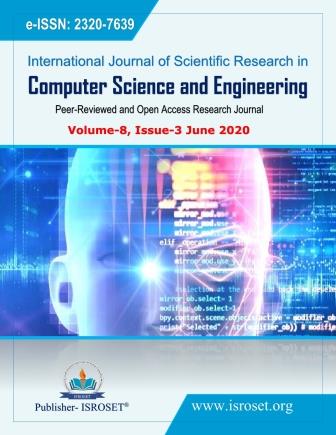Correlation study of New Cases, Deaths, Recoveries and Temperature with Machine Learning during COVID-19 spread in Saudi Arabia
Keywords:
Coronavirus, COVID-19, k-means, clustering, Machine Learning, correlationAbstract
Millions of people have been infected and killed by the recent outbreak of novel coronavirus throughout the world. It has affected 210 countries around the globe and two International conveyances [1]. It has evolved from epidemic to pandemic crossing all physical, socio economic and geographic barriers. The untraceable virus mutations can quickly effect hundreds of people before the antibodies are developed by the immune system. Since its first inception in Wuhan, the virus has rapidly influenced all nooks and corners of the tightly connected world. The imperative lethality of the virus varies from hot temperature to cold climates. There have been different impacts of COVID-19 on different races, geographical conditions and socio-cultural environments. It is evident that temperature is a critical factor for incubation period of pathogens. This research paper tries to find out the correlation among various factors such as infections, deaths, recoveries of the patients infected with COVID-19 with respect to the Temperature with the help of k-means clustering
References
COVID-19 Coronavirus Pandemic. https://www.worldometers.info/coronavirus/ extracted on April 27, 2020
The Nonstructural Proteins Directing Coronavirus RNA Synthesis and Processing. https://www.sciencedirect.com/science/article/pii/S0065352716300471?via%3Dihub
Human Coronavirus Types. https://www.cdc.gov/coronavirus/types.html
Rolling updates on coronavirus disease (COVID-19). https://www.who.int/emergencies/diseases/novel-coronavirus-2019/events-as-they-happen
WHO Director-General`s statement on IHR Emergency Committee on Novel Coronavirus (2019-nCoV). https://www.who.int/dg/speeches/detail/who-director-general-s-statement-on-ihr-emergency-committee-on-novel-coronavirus-(2019-ncov)
Coronavirus Worldwide Graphs. https://www.worldometers.info/coronavirus//worldwide-graphs/ extracted on April 27, 2020
3D medical animation corona virus. https://commons.wikimedia.org/wiki/File:3D_medical_animation_corona_virus.jpg
https://www.scientificanimations.com (https://commons.wikimedia.org/wiki/File:3D_medical_animation_corona_virus.jpg), https://creativecommons.org/licenses/by-sa/4.0/legalcode
MOH Reports First Case of Coronavirus Infection https://www.moh.gov.sa/en/Ministry/MediaCenter/News/Pages/News-2020-03-02-002.aspx
Srivastav V, Issenhuth T, Kadkhodamohammadi A, de Mathelin M, Gangi A, Padoy N. (2018). MVOR: A multi-view RGB-D operating room dataset for 2D and 3D human pose estimation. arXiv[Preprint].arXiv:1808.08180. Retrieved from: https://arxiv.org/pdf/1808.08180.pdf
Alashwal H, El Halaby M, Crouse J J, Abdalla A, Moustafa A A. ?The application of unsupervised clustering methods to Alzheimer?s disease?. Front Comput Neurosci, 13(issue): pp. 1-9, 2019.
Nithya N, Duraiswamy K, Gomathy P. ?A survey on clustering techniques in medical diagnosis.? Int J Comput Sci Trends Technol, 1(issue): 17-23, 2013.
Nikas J B, Low W C. ?Application of clustering analyses to the diagnosis of Huntington?s disease in mice and other diseases with well- defined group boundaries.? Comput Methods Programs Biomed, 104(3): e133-e147, 2011.
Polat K. ?Classification of Parkinson?s disease using feature weighting method on the basis of fuzzy 366 c-means clustering.? Int J Syst Sci, 43(issue): 597-609, 2012;.
Chen C -H. ?A hybrid intelligent model of analyzing clinical breast cancer data using clustering techniques with feature selection.? Appl Soft Comput, 20(issue): 4-14, 2014.
Yilmaz N, Inan O, Uzer M S. ?A new data preparation method based on clustering algorithms for diagnosis systems of heart and diabetes diseases.? J Med Syst, 38(5): 48, 2014.
Trevithick L, Painter J, Keown P. ?Mental health clustering and diagnosis in psychiatric in-patients.? BJPsych Bull, 39(issue):pp. 119-123, 2015.
Wu Y, Duan H, Du S. ?Multiple fuzzy c-means clustering algorithm in medical diagnosis.? Technol Health Care, 23(issue): pp.S519-S527, 2015.
Nilashi M, Ibrahim O, Ahani A. ?Accuracy improvement for predicting Parkinson?s disease progression.? Sci Rep, 6(issue): 34181, 2016.
Gamberger D, Lavrac N, Srivatsa S, Tanzi R E, Doraiswamy P M. ?Identification of clusters of rapid and slow decliners among subjects at risk for Alzheimer?s disease.? Sci Rep, 7(issue): pp.63-67, 2017;.
Siddiqui M K, Morales-Menendez R, Gupta P, Iqbal H, Hussain F, Khatoon K, Ahmad S. ?Correlation Between Temperature and COVID-19 (Suspected, Confirmed and Death) Cases based on Machine Learning Analysis.? J Pure Appl Microbiol, 14(Spl Edn.), 2020.
Eibe F, Mark AH, Ian HW. 2016. The WEKA Workbench. Online Appendix for "Data Mining: Practical Machine Learning Tools and Techniques", Morgan Kaufmann, Fourth Edition, 2016.
Mark H, Eibe F, Geoffrey H, Bernhard P, Peter R, Ian H W. ?The WEKA Data Mining Software: An Update.? SIGKDD Explorations, 11(1): pp.10-18, 2009.
Downloads
Published
How to Cite
Issue
Section
License

This work is licensed under a Creative Commons Attribution 4.0 International License.
Authors contributing to this journal agree to publish their articles under the Creative Commons Attribution 4.0 International License, allowing third parties to share their work (copy, distribute, transmit) and to adapt it, under the condition that the authors are given credit and that in the event of reuse or distribution, the terms of this license are made clear.







